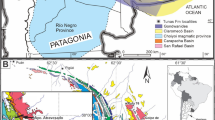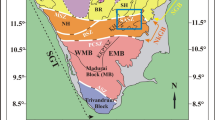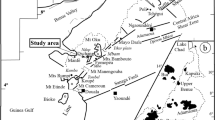Abstract
The Koraput Alkaline Complex (KAC) lies on the NE-SW trending Sileru Shear Zone (SSZ) separating the Proterozoic Eastern Ghats Province from the Archaean Indian craton. The core of the KAC is made of hornblende gabbro, which is rimmed by a band of nepheline syenite in the east and syenodiorite in the west. The timing of magmatism with respect to the SSZ is disputed. The KAC was deformed during emplacement, and a magmatic foliation related to the syn-emplacement deformation, D 1 , is present in the gabbroic core. The dominant D 2 -related field fabric strikes NESW and is penetrative in parts of the gabbro and marginal lithologies. E-W trending D 3 shear zones cut across the complex. Distinct textural domains resulted from strain partitioning during deformation. Parts of the complex with magmatic textures constitute Domain-1, while D 2 and D 3 fabric zones comprise Domains-2 and 3 respectively. Temperatures in the KAC initially decreased following D 1 , but increased through D 2 and D 3 . Anisotropy of magnetic susceptibility (AMS) studies show that the magnetic fabric generally follows S 1 in Domain-1. While the magnetic fabric in Domain-2 is dominantly parallel to S 2 , some of it parallels S 1 . The latter is a relict D 1 fabric that is recognized from AMS analysis but is obliterated in the field, which confirms that the KAC pre-dates the SSZ. The response of magnetic fabrics to temperature and implications of the study for Indo-Antarctica amalgamation are discussed.
Similar content being viewed by others
References
Aftalion, M., Bowes, D.R., Dash, B. and Fallick, A.E. (2000) Late Pan-African thermal history in the Eastern Ghats terrane, India, from U-Pb and K-Ar isotopic study of the Mid-Proterozoic Khariar alkali syenite,Orissa. Geol. Surv. India, Spec. Publ., v.57, pp.26–33.
Archanjo, C.J. and Bouchez, J.L. (1997) Magnetic fabrics and microstructures of the post-collisional aegirine-augite syenite Triunfo pluton, NE Brazil. Jour. Struc. Geol., v.19, pp.849–860.
Archanjo, C.J., Launeau, P. and Bouchez, J. L. (1995) Magnetic fabric vs. magnetite and biotite shape fabrics of the magnetite bearing granite pluton of Gamelerias (northeast Brazil). Physics Earth Planet. Int., v.89, pp.63–75.
Archanjo, C.J., Macedo, J.W.P., Galindo, A.C. and Araujo, M.G.S. (1998) Brasiliano crustal extension and emplacement fabrics of the mangerite-charnockite pluton of Umarizal, Northeast Brazil. Precambrian Res., v.87, pp.19–32.
Bailey, D. K. (1992) Episodic alkaline activity across Africa: implications for the causes of continental break-up. In: B.C. Storey, T. Alabaster and R.J. Pankhurst (Eds.), Magmatism and the causes of continental break-up. Geol. Soc. London Spec. Publ., v.68, pp.91–98.
Bell, T.H. (1978) Syntectonic nucleation of new grains in deformed mica. Tectonophysics, v.51, pp.T31–T37.
Bell, T.H. (1979) The defomation and recrystallization of biotite in the Woodroffe Thrust mylonite zone. Tectonophysics, v.58, pp.139–158.
Bhadra, S., Gupta, S. and Banerjee, M. (2004) Structural evolution across the Eastern Ghats Mobile Belt — Bastar craton boundary, India: hot over cold thrusting in an ancient collision zone. Jour. Struc. Geol., v.26, pp.233–245.
Bhattacharya, S. and Kar, R. (2004) Alkaline intrusion in a granulite ensemble in the Eastern Ghats belt, India: shear zone pathway and a pull-apart structure. Proc. Indian Acad. Sci. (Earth and Planet. Sci.) v.113, pp.37–48.
Bhattacharya, S. and Kar, R. (2005) Petrological and Geochemical Constraints on the Evolution of the Alkaline Complex of Koraput in the Eastern Ghats Granulite Belt, India. Gondwana Res., v.8, no.4, pp.596–602.
Blenkinsop, T. (2000) Deformation Microstructures and Mechanisms in Minerals and Rocks. Kluwer Academic Publishers, Dordrecht.
Bolle, O., Diot, H. and Duchesne, J.C. (2000) Magnetic fabric and deformation in charnockitic igneous rocks of the Bjerkreim-Sokndal layered intrusion (Rogaland, Southwest Norway). Jour. Struc. Geol., v.22, pp. 647–667.
Borradaile, G.J. and Henry, B. (1997) Tectonic applications of magnetic susceptibility and its anisotropy. Earth Sci. Rev., v.42, pp.49–93.
Bose, M. K. (1964) Observation on the nepheline syenites of Koraput, Orissa. Geol. Mag., v.101, pp.558–563.
Bose, M.K. (1965) Differentiation of alkali basaltic magma. Nature, v.207, pp.1187–1188.
Bose, M.K. (1970) Petrology of the intrusive alkaline suite of Koraput, Orissa. Jour. Geol. Soc. India, v.11, pp.99–126.
Bose, M.K. (1971) Structure of the alkali complex and associated metamorphites of Koraput, Orissa. In: T. Murthy, and S.S. Roy, (Eds.), Studies in Earth Sciences (W.D. West Volume). Today and Tomorrow’s Printers and Publishers, New Delhi, pp.280–288.
Bouchez, J. L. (1997) Granite is never isotropic: an introduction to AMS studies of granitic rocks, In: Bouchez, J.L., Hutton, D.W.H. Stephens, W.E. (Eds.), Granite: From Segregation of Melt to Emplacement Fabrics, Kluwer Acad. Publ., Dordrecht, The Netherlands, pp.95–112.
Burke, K., Ashwal, L.D. and Webb, S.J. (2003) New way to map old sutures using deformed alkaline rocks and carbonatites. Geology, v.31, pp.391–394.
Chetty, T.R.K. and Murthy, D.S.N. (1994) Collision tectonics in the Eastern Ghats Mobile Belt: mesoscopic to satellite scale structural observations. Terra Nova, v.6, pp.72–81.
Chetty, T.R.K. and Murthy, D.S.N. (1998) Elchuru — Kunavaram — Koraput (EKK) Shear Zone, Eastern Ghats Granulite Terrane, India: a possible Precambrian suture zone. In: A.T. Rao, S.R. Divi and M. Yoshida (Eds.), Precambrian crustal processes in East Gondwana. Gondwana Res, Group Mem., no.4, pp.37–48.
Clark, G.S. and Subbarao, K.V. (1971) Rb-Sr isotopic age of the Kunavaram Series — a group of alkaline rocks from India. Canadian Jour. Earth Sci., v.8, pp.1597–1602.
Collins, A.S. and Pisarevsky, S.A. (2005) Amalgamating eastern Gondwana: the evolution of the Circum-Indian orogens. Earth Sci. Rev., v.71, no.3–4, pp.229–270.
Cowan, J.E. (1999) Magnetic fabric constraints on the initial geometry of the Sudbury Igneous Complex: a folded sheet or a basin-shaped igneous body? Tectonophysics, v.307, pp.135–162.
Cruden, A.R. and Launeau, P. (1994) Structure, magnetic fabric and emplacement of the Archean Lebel Stock, SW Abitibi Greenstone Belt. Jour. Struc. Geol., v.16, pp.677–691.
Czygan, W. and Goldenberg, G. (1989) Petrography and geochemistry of the alkaline complexes of Sivamalai, Elchuru and Uppalapadu, India. Mem. Geol. Soc. India, no.15, pp.225–240.
Dobmeier, C. and Raith, M. (2003) Crustal architecture and evolution of the Eastern Ghats Belt and adjacent regions of India. In: M. Yoshida, B.F. Windley and S. Dasgupta (Eds.), Proterozoic East Gondwana: supercontinent assembly and breakup. Geol. Soc. London, Spec. Publ., v.206, pp.145–168.
Etheridge, M.A. and Hobbs, B.E. (1974) Chemical and deformational controls on recrystallization of mica. Contrib. Mineral. Petrol., v.43, pp.111–124.
Ferré, E.C., Bordarier, C. and March, J.S. (2002) Magma flow inferred from AMS fabrics in a layered mafic sill, Insizwa, South Africa. Tectonophysics, v.354, pp.1–23.
Gapais, D. (1989) Shear structures within deformed granites: mechanical and thermal indicators. Geology, v.17, pp.1144–1147.
Gupta, S. (2004) The Eastern Ghats Belt, India — a new look at an old orogen. In: Uniformitarianism revisited — comparison between ancient and modern orogens of India. Geol. Surv. India, Spec. Publ., no.84, pp.75–100.
Gupta, S. and Bhattacharya, A. (2000) Granulites of the ‘Transition Zone’: implications for the westward reach of the Eastern Ghats Belt. Geol. Surv. India Spec. Publ., v.57, pp.57–66.
Gupta, S. and Bose, S. (2004) Deformation history of the Kunavaram Complex, Eastern Ghats Belt, India: implications for alkaline magmatism along the Indo-Antarctica suture. Gondwana Res. (Gondwana Newsletter section), v.7, no.4, pp.1235–1241.
Gupta, S., Nanda, J., Mukherjee, S. and Santra, M. (2005) Alkaline Magmatism Versus Collision Tectonics in the Eastern Ghats Belt, India: Contraints from Structural studies in the Koraput Complex. Gondwana Res., v.8, no.3, pp.403–419.
Hacker, B.R. and Christie, J.M. (1990) Brittle/ductile and plastic/cataclastic transition in experimentally deformed and metamorphosed amphibolite. In: A.G. Duba, W.B. Durham, J.W. Handin and H.F. Wang (Eds.), The brittle-ductile transition in rocks (The Heard Volume). Amer. Geophys. Union Monograph, v.56, pp.127–146.
Hrouda, F. (1993) Theoretical models of magnetic anisotropy to strain relationship revisited. Physics Earth Planet. Int., v.77, pp.237–249.
Kronenberg, A.K., Kirby, S.H. and Pinkston, J. (1990) Basal slip and mechanical anisotropy of biotite. Jour. Geophys. Res., v.95, pp.19257–19279.
Kruhl, J.H. (1996) Prism- and basal-plane parallel subgrain boundaries in quartz: a microstructural geothermobarometer. Jour. Metamor. Geol., v.14, pp.581–589.
Madhavan, V. and Khurram, M.Z.A.K. (1989) The alkaline gneisses of Khariar, Kalahandi district, Orissa. Mem. Geol. Soc. India, no.15, pp.265–289.
Majumder, S. and Mamtani, M.A. (2009) Magnetic fabric in the Malanjkhand Granite (Central India) — Implications for regional tectonics and Proterozoic suturing of the Indian shield. Phys. Earth Planet. Int., v.172, pp.310–323.
Mamtani, M.A. and Arora, B.R. (2005) Anisotropy of magnetic susceptibility-a useful tool for analyses of naturally deformed rocks. Himalayan Geol., v.26, pp.175–186.
Mamtani, M.A. and Greiling, R.O. (2005) Granite emplacement and its relation with regional deformation in the Aravalli Mountain Belt-inferences from magnetic fabric. Jour. Struc. Geol., v.27, pp.2008–2029.
Mamtani, M.A. and Sengupta, A. (in press) Anisotropy of magnetic susceptibility analysis of deformed kaolinite: implications for evaluating landslides. Int. Jour. Earth Sci., doi: 10.1007/s00531-008-0336-x.
Mezger, K. and Cosca, M. A. (1999) The thermal history of the Eastern Ghats Belt (India), as revealed by U-Pb and 40Ar-39Ar dating of metamorphic and magmatic minerals: implications for the SWEAT correlation. Precambrian Res., v.94, pp.251–271.
Mukherji, M.A., Chaudhuri, A.K. and Mamtani, M.A. (2004) Regional scale strain variations in Banded Iron Formations of eastern India: results from anisotropy of magnetic susceptibility studies. Jour. Struct. Geol., v.26, pp.2175–2189.
Nanda, J., Dobmeier, C.J. and Gupta, S. (2004) Pre-Tectonic Alkaline Magmatism in a Proterozoic Orogen: Evidence from metamorphosed syenite veins in the Koraput complex, Eastern Ghats Province, India. Geoscience Africa 2004, Abstract Volume, University of the Witwatersrand, Johannesburg, South Africa, pp.26–27.
Nanda, J., Gupta, S. and Dobmeier, C.J. (2008) Metamorphism of the Koraput Alkaline Complex, Eastern Ghats Province, India — evidence for reworking of a granulite terrane. Precamrian Res., v 165, pp.153–168.
Nagaraju, J., Chetty, T.R.K., Vara Prasad, G.S. and Patil, S.K. (2008) Transpressional tectonics during the emplacement of Pasupugallu Gabbro Pluton, western margin of Eastern Ghats Mobile Belt, India: evidence from AMS fabrics. Precambrian Res., v.162, pp. 86–101.
O’Driscoll, B., Hargraves, R.B., Emeleus, C.H., Troll, V.R., Donaldson, C.H. and Reavy, R.J. (2007) Magmatic lineations inferred from anisotropy of magnetic susceptibility fabrics in Units 8, 9, and 10 of the Rum Eastern Layered Series, NW Scotland. Lithos, v.98, pp.27–44.
Powell, C.M. and Pisarevsky, S.A. (2002) Late Neoproterozoic assembly of East Gondwana. Geology, v.30, pp.3–6.
Ramakrishnan, M., Nanda, J.K. and Augustine, P.F. (1998) Geological evolution of the Proterozoic Eastern Ghats Mobile Belt. Geol. Surv. India, Spec. Publ., no.44, pp.1–21.
Praveen, K.R., Prasannakumar, V. and Mamtani, M.A. (in press). Time relationship between regional deformation and fabric development in the peralimala pluton, south india — inferences from magnetic fabric. Jour. Geol. Soc. India.
Rickers, K., Mezger, K. and Raith, M.M. (2001) Evolution of the continental crust in the Proterzoic Eastern Ghats Belt, India and new constraints for Rodinia reconstruction: Implications from Sm-Nd, Rb-Sr, and Pb-Pb isotopes. Precambrian Res., v.112, pp.183–212.
Rosenberg, C.L. and Stünitz, H. (2003) Deformation and recrystallization of plagioclase along a temperature gradient: an example from the Bergell tonalite. Jour. Struct. Geol., v.25, pp.389–408.
Sarkar, A., Nanda, J.K., Paul, D.K., Bishui, P.K. and Gupta, S.N. (1989) Late Proterozoic alkaline magmatism in the Eastern Ghats Belt: Rb-Sr isotopic study on the Koraput complex, Orissa. Indian Minerals, v.43, pp.265–272.
Sarkar, M., Gupta, S. and Panigrahi, M. K. (2007) Disentangling tectonic cycles along a multiply deformed terrane margin: structural and metamorphic evidence for mid-crustal reworking of the Angul granulite complex, Eastern Ghats Belt, India. Jour. Struct. Geol., v.29, pp.802–818.
Sen, K. and Mamtani, M.A. (2006) Magnetic fabric, shape preferred orientation and regional strain in granitic rocks. Jour. Struct. Geol., v.28, pp.1870–1882.
Sen, K., Majumder, S. and Mamtani, M.A. (2005). Degree of magnetic anisotropy as a strain intensity gauge in ferromagnetic granites. Jour. Geol. Soc., London, v.162, pp.583–586.
Shea, W.T. and Kronenberg, A.K. (1992) Rheology and deformation mechanisms of an isotropic mica schist. Jour. Geophy. Res., v.97, pp.15201–15237.
Shelley, D. (1994) Spider texture and amphibole preferred orientations. Jour. Struct. Geol., v.16, pp.709–717.
Stipp, M., Stünitz, H., Heilbronner, R. and Schmid, S.M. (2002) The eastern Tonale fault zone: a ‘natural laboratory’ for crystal plastic deformation of quartz over a temperature range from 250–700°C. Jour. Struct. Geol., v.24, pp.1861–1884.
Subbarao, K.V. (1971) The Kunavaram Series — a group of alkaline rocks, Khammam District, Andhra Pradesh, India. Jour. Petrol., v.12, pp.621–641.
Subba Rao, T.V., Bhaskar Rao, Y.J., Sivaraman, T.V. and Gopalan, K. (1989) Rb-Sr age and petrology of the Elchuru Alkaline Complex: implications to alkaline magmatism in the Eastern Ghat Mobile Belt. Mem.Geol. Soc. India, no.15, pp.207–223.
Tarling, D.H. and Hrouda, F. (1993) The Magnetic Anisotropy of Rocks. Chapman and Hall, London.
Torsvik, T.H., Carter, L.M., Ashwal, L.D., Bhushan, S. K., Pandit, M.K. and Jamtveit, B. (2001) Rodinia refined or obscured: palaeomagnetism of the Malani igneous suite (NW India). Precambrian Res., v.108, pp.319–333.
Tripathy, N.R., Srivastava, H.B. and Mamtani, M.A. (2009) Evaluation of regional strain gradient in mylonitic quartzites from the footwall of the Main Central Thrust Zone (Garhwal Himalaya, India): inferences from finite strain and AMS analyses. Jour. Asian Earth Sci., v.34, pp.26–37.
Upadhyay, D., Raith, M., Mezger, E.K., Bhattacharya, A. and Kinny, E.P.D. (2006) Mesoproterozoic rifting and Pan-African continental collision in SE India: evidence from the Khariar alkaline complex. Contrib. Mineral. Petrol., v.151, pp.434–456.
Vernon, R.H. (1977) Microfabric of mica aggregates in partly recrystallized biotite. Contrib. Mineral. Petrol., v.61, pp.175–185.
Vernon, R.H., Johnson, S.H. and Melis, E.A. (2004) Emplacement-related microstructures in the margin of a deformed pluton: the San José tonalite, Baja California, Mexico. Jour. Struct. Geol., v.26, pp.1867–1884.
Author information
Authors and Affiliations
Corresponding author
Rights and permissions
About this article
Cite this article
Nanda, J., Gupta, S. & Mamtani, M.A. Analysis of deformation fabric in an Alkaline Complex (Koraput): Implications for time relationship between emplacement, fabric development and regional tectonics. J Geol Soc India 74, 78–94 (2009). https://doi.org/10.1007/s12594-009-0093-x
Received:
Revised:
Published:
Issue Date:
DOI: https://doi.org/10.1007/s12594-009-0093-x




